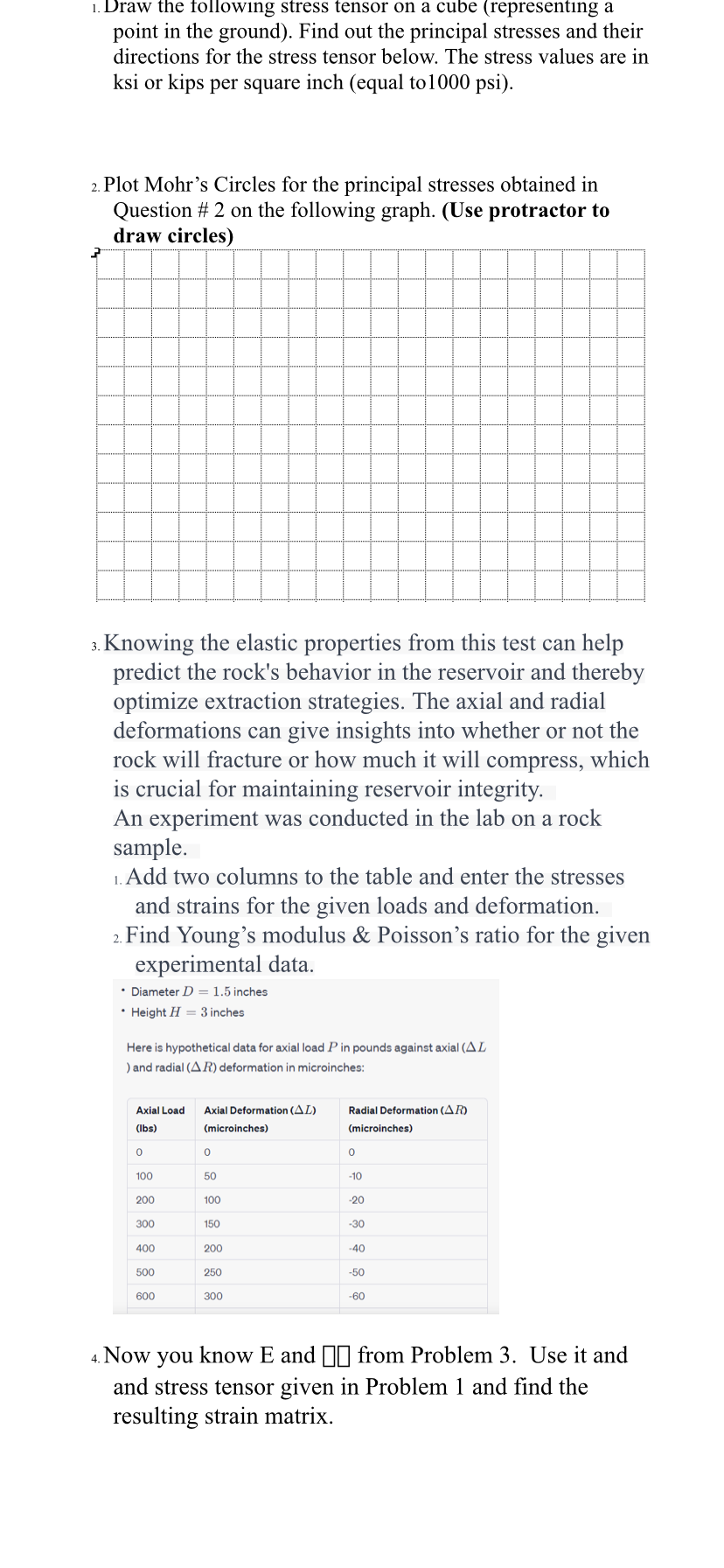Answered step by step
Verified Expert Solution
Question
1 Approved Answer
1. Draw the following stress tensor on a cube (representng a point in the ground). Find out the principal stresses and their directions for the

 1. Draw the following stress tensor on a cube (representng a point in the ground). Find out the principal stresses and their directions for the stress tensor below. The stress values are in ksi or kips per square inch (equal to1000 psi). 2. Plot Mohr's Circles for the principal stresses obtained in Question \# 2 on the following graph. (Use protractor to draw circles) 3. Knowing the elastic properties from this test can help predict the rock's behavior in the reservoir and thereby optimize extraction strategies. The axial and radial deformations can give insights into whether or not the rock will fracture or how much it will compress, which is crucial for maintaining reservoir integrity. An experiment was conducted in the lab on a rock sample. 1. Add two columns to the table and enter the stresses and strains for the given loads and deformation. 2. Find Young's modulus \& Poisson's ratio for the given experimental data. - Diameter D=1.5 inches - Height H=3 inches Here is hypothetical data for axial load P in pounds against axial ( L ) and radial (R) deformation in microinches: 4. Now you know E and QD from Problem 3. Use it and and stress tensor given in Problem 1 and find the resulting strain matrix. 1. Draw the following stress tensor on a cube (representing a point in the ground). Find out the principal stresses and their directions for the stress tensor below. The stress values are in ksi or kips per square inch (equal to1000 psi). 2. Plot Mohr's Circles for the principal stresses obtained in Question \# 2 on the following graph. (Use protractor to draw circles) 3. Knowing the elastic properties from this test can help predict the rock's behavior in the reservoir and thereby optimize extraction strategies. The axial and radial deformations can give insights into whether or not the rock will fracture or how much it will compress, which is crucial for maintaining reservoir integrity. An experiment was conducted in the lab on a rock sample. 1. Add two columns to the table and enter the stresses and strains for the given loads and deformation. 2. Find Young's modulus \& Poisson's ratio for the given experimental data. - Diameter D=1.5 inches - Height H=3 inches Here is hypothetical data for axial load P in pounds against axial (L ) and radial (R) deformation in microinches: 1. Draw the following stress tensor on a cube (representng a point in the ground). Find out the principal stresses and their directions for the stress tensor below. The stress values are in ksi or kips per square inch (equal to1000 psi). 2. Plot Mohr's Circles for the principal stresses obtained in Question \# 2 on the following graph. (Use protractor to draw circles) 3. Knowing the elastic properties from this test can help predict the rock's behavior in the reservoir and thereby optimize extraction strategies. The axial and radial deformations can give insights into whether or not the rock will fracture or how much it will compress, which is crucial for maintaining reservoir integrity. An experiment was conducted in the lab on a rock sample. 1. Add two columns to the table and enter the stresses and strains for the given loads and deformation. 2. Find Young's modulus \& Poisson's ratio for the given experimental data. - Diameter D=1.5 inches - Height H=3 inches Here is hypothetical data for axial load P in pounds against axial ( L ) and radial (R) deformation in microinches: 4. Now you know E and QD from Problem 3. Use it and and stress tensor given in Problem 1 and find the resulting strain matrix. 1. Draw the following stress tensor on a cube (representing a point in the ground). Find out the principal stresses and their directions for the stress tensor below. The stress values are in ksi or kips per square inch (equal to1000 psi). 2. Plot Mohr's Circles for the principal stresses obtained in Question \# 2 on the following graph. (Use protractor to draw circles) 3. Knowing the elastic properties from this test can help predict the rock's behavior in the reservoir and thereby optimize extraction strategies. The axial and radial deformations can give insights into whether or not the rock will fracture or how much it will compress, which is crucial for maintaining reservoir integrity. An experiment was conducted in the lab on a rock sample. 1. Add two columns to the table and enter the stresses and strains for the given loads and deformation. 2. Find Young's modulus \& Poisson's ratio for the given experimental data. - Diameter D=1.5 inches - Height H=3 inches Here is hypothetical data for axial load P in pounds against axial (L ) and radial (R) deformation in microinches
1. Draw the following stress tensor on a cube (representng a point in the ground). Find out the principal stresses and their directions for the stress tensor below. The stress values are in ksi or kips per square inch (equal to1000 psi). 2. Plot Mohr's Circles for the principal stresses obtained in Question \# 2 on the following graph. (Use protractor to draw circles) 3. Knowing the elastic properties from this test can help predict the rock's behavior in the reservoir and thereby optimize extraction strategies. The axial and radial deformations can give insights into whether or not the rock will fracture or how much it will compress, which is crucial for maintaining reservoir integrity. An experiment was conducted in the lab on a rock sample. 1. Add two columns to the table and enter the stresses and strains for the given loads and deformation. 2. Find Young's modulus \& Poisson's ratio for the given experimental data. - Diameter D=1.5 inches - Height H=3 inches Here is hypothetical data for axial load P in pounds against axial ( L ) and radial (R) deformation in microinches: 4. Now you know E and QD from Problem 3. Use it and and stress tensor given in Problem 1 and find the resulting strain matrix. 1. Draw the following stress tensor on a cube (representing a point in the ground). Find out the principal stresses and their directions for the stress tensor below. The stress values are in ksi or kips per square inch (equal to1000 psi). 2. Plot Mohr's Circles for the principal stresses obtained in Question \# 2 on the following graph. (Use protractor to draw circles) 3. Knowing the elastic properties from this test can help predict the rock's behavior in the reservoir and thereby optimize extraction strategies. The axial and radial deformations can give insights into whether or not the rock will fracture or how much it will compress, which is crucial for maintaining reservoir integrity. An experiment was conducted in the lab on a rock sample. 1. Add two columns to the table and enter the stresses and strains for the given loads and deformation. 2. Find Young's modulus \& Poisson's ratio for the given experimental data. - Diameter D=1.5 inches - Height H=3 inches Here is hypothetical data for axial load P in pounds against axial (L ) and radial (R) deformation in microinches: 1. Draw the following stress tensor on a cube (representng a point in the ground). Find out the principal stresses and their directions for the stress tensor below. The stress values are in ksi or kips per square inch (equal to1000 psi). 2. Plot Mohr's Circles for the principal stresses obtained in Question \# 2 on the following graph. (Use protractor to draw circles) 3. Knowing the elastic properties from this test can help predict the rock's behavior in the reservoir and thereby optimize extraction strategies. The axial and radial deformations can give insights into whether or not the rock will fracture or how much it will compress, which is crucial for maintaining reservoir integrity. An experiment was conducted in the lab on a rock sample. 1. Add two columns to the table and enter the stresses and strains for the given loads and deformation. 2. Find Young's modulus \& Poisson's ratio for the given experimental data. - Diameter D=1.5 inches - Height H=3 inches Here is hypothetical data for axial load P in pounds against axial ( L ) and radial (R) deformation in microinches: 4. Now you know E and QD from Problem 3. Use it and and stress tensor given in Problem 1 and find the resulting strain matrix. 1. Draw the following stress tensor on a cube (representing a point in the ground). Find out the principal stresses and their directions for the stress tensor below. The stress values are in ksi or kips per square inch (equal to1000 psi). 2. Plot Mohr's Circles for the principal stresses obtained in Question \# 2 on the following graph. (Use protractor to draw circles) 3. Knowing the elastic properties from this test can help predict the rock's behavior in the reservoir and thereby optimize extraction strategies. The axial and radial deformations can give insights into whether or not the rock will fracture or how much it will compress, which is crucial for maintaining reservoir integrity. An experiment was conducted in the lab on a rock sample. 1. Add two columns to the table and enter the stresses and strains for the given loads and deformation. 2. Find Young's modulus \& Poisson's ratio for the given experimental data. - Diameter D=1.5 inches - Height H=3 inches Here is hypothetical data for axial load P in pounds against axial (L ) and radial (R) deformation in microinches Step by Step Solution
There are 3 Steps involved in it
Step: 1

Get Instant Access to Expert-Tailored Solutions
See step-by-step solutions with expert insights and AI powered tools for academic success
Step: 2

Step: 3

Ace Your Homework with AI
Get the answers you need in no time with our AI-driven, step-by-step assistance
Get Started


